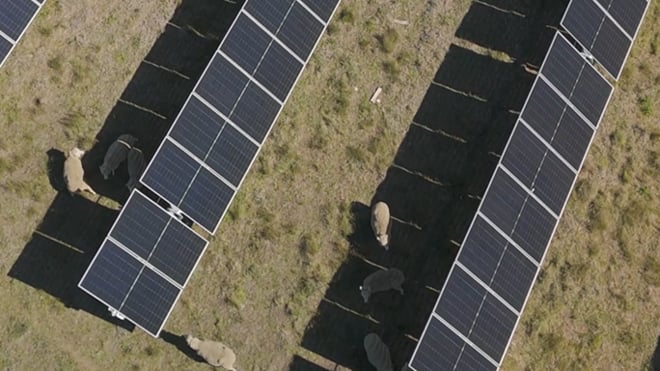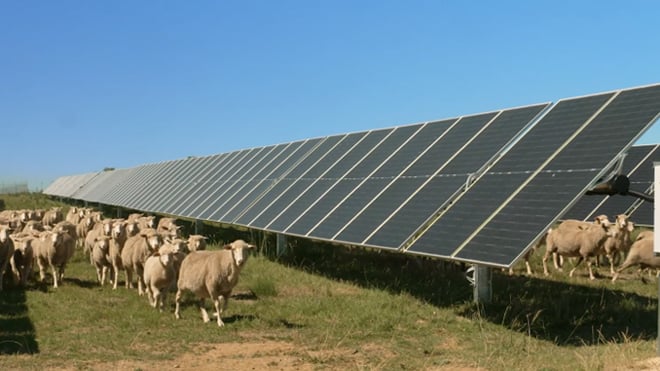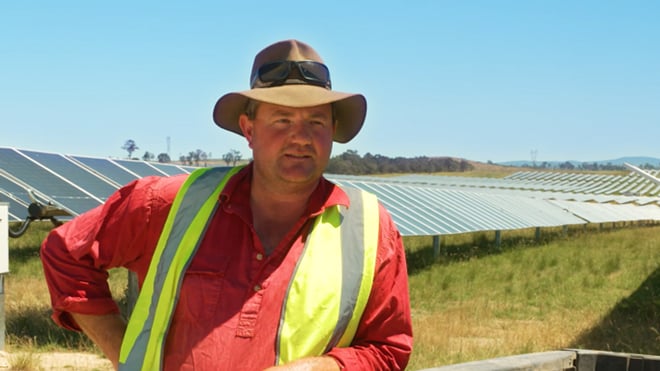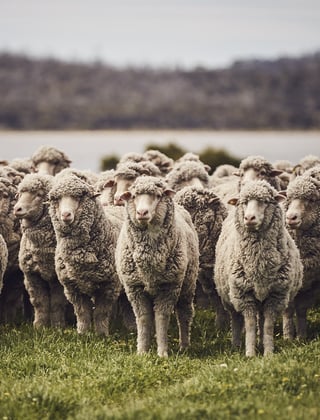Solar grazing provides fibre, food and energy

More than 6,000 Merino and crossbred sheep now graze at one of Australia’s newest solar farms, with early indications pointing to a win-win for wool-growing and renewable energy production.
Solar grazing is the practice of livestock (usually sheep, due to their lower height) grazing the land on which solar farms are located. It is an example of dual land use, one that provides fibre and meat from the sheep, but also renewable energy. Both activities can coexist harmoniously.
Furthermore, the use of solar panels will likely ensure the land is net positive for greenhouse gas emissions, which could open up new marketing opportunities for the wool from sheep that graze there.
The advantage of solar grazing for the energy companies operating a solar farm is that the sheep reduce vegetation growth under the solar panels, thereby reducing on-site fire risks and the need for (and cost of) mechanical or chemical removal.
Solar grazing is relatively new and not without its critics, some of whom have argued against solar farms for aesthetic reasons, while others have been sceptical about the number of sheep able to be run on the farms. However, reports from farmers who have been involved in solar grazing, in Australia and other countries, generally seem to be positive.
The panels provide the sheep with protection from the sun and shelter from rain. The panels can also improve pasture growth by providing shade and facilitating more moisture, which could lead to increased carrying capacity.
Sheep producers leasing their land to electricity generation companies can receive an extra, lucrative and guaranteed source of revenue for decades, and they can still graze the land.
In addition to the existing solar farms that incorporate solar grazing in Australia, there are several others solar farms currently proposed or being commercially developed by renewable energy companies.
Solar grazing at New England Solar

Some of the 6,500 sheep that graze the New England Solar site, one of Australia’s newest and largest solar farms, near Uralla.
One of Australia’s newest and largest solar farms, New England Solar, 6km east of Uralla in NSW, is designed specifically to incorporate solar grazing.
The solar farm is being developed, constructed and operated by ACEN Australia in two stages across 2,000 hectares of cleared grazing land leased from local landholders. Once completed, ACEN Australia estimates it will provide enough clean renewable power for around 300,000 homes. Construction of the first stage was completed last year, with about one million solar panels installed.
Sheep and lambs have been grazing the 1,200 hectare site since Christmas, with extra mobs introduced gradually during that time to help them transition to their new feeding ground. There is currently a flock of about 6,500 Merinos and crossbreds grazing the site.
They spend six weeks on the site, before being mustered back to the yards for health checks, and then they move on to other paddocks or straight back to their green solar pastures.
Drinking water for the sheep is provided by natural dams on part of the site, while in other locations pipes bring water to the site from bores on neighbouring farms.
The panels rotate east-west throughout the day, as they track the sun to maximise the amount of energy produced, thereby providing a balance between light and shade for the pasture and the sheep.
As part of the development of the solar farm, New England Solar has also contributed to the wider Uralla community by supporting local businesses, and sporting and community organisations.
Positive woolgrower feedback

Superfine woolgrower Cameron Wood says his sheep adjusted very quickly to grazing on the New England Solar site.
It will take a few seasons and shearings to properly assess the productivity of the Merino and crossbred sheep, as well as the full benefits of running them on the solar farm at Uralla. However, the landholders running sheep there say the early signs look positive.
Superfine woolgrower Cameron Wood is the fifth generation of his family to run sheep on the land, which has been in the family for about 140 years. The Woods run a Merino, fat lamb and cattle business, with a focus on wool produced from Saxon Merinos. Cameron Wood says the fleece from his solar grazing Saxon Merinos is bound for the export market in Italy, where it will be turned into high end fashion.
“It’s been really exciting for us to first see the solar panels on the land to help us drought proof our operations, and then to bring the sheep back to the land to feed under the panels,” Cameron said.
“The fresh grass and shade are a great combination – the sheep just look really happy. We’re looking forward to getting them in the sheds this winter for shearing, and their wool baled up for market.”
Fifth-generation woolgrower Richard Munsie is another of several local producers that graze sheep at the New England Solar project.
Richard says the panels create their own microclimate, which is an ideal environment for the ewes.
“They shade the early morning pastures which prolongs the effects of the dew. That helps the grass grow. And the panels also give shade to sheep and protection from frosts,” he said.
“We might even be able to run more sheep due to the climate created by the panels, but we’ll see.”
This article appeared in the June 2024 edition of AWI’s Beyond the Bale magazine. Reproduction of the article is encouraged.














